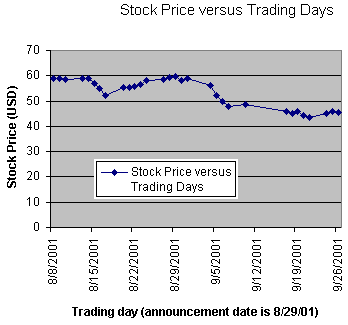Design team members: Wilbert Aballe and Gosia Garus
Supervisor:Tony Wirjanto, Department of Economics
Background
Fact: More than half of all mergers and acquisitions fail to reach their promised strategic and financial goals.
Fact :In 2000, companies spent $3.3 trillion on mergers and acquisitions, meaning that more than $1.6 trillion of that money spent failed to produce the expected value for the acquiring company’s shareholders.
Consequently, investors typically sell-off their shares in an acquiring company, demonstrating the market efficiency hypothesis that states that “in an active market that includes many well-informed and intelligent investors, securities will be appropriately priced and reflect all available information”. This means that investors know that acquisitions often destroy value.
Project description
This project seeks to develop a sound understanding of acquisition success and failure rates. The analysis is based on a methodology comprised of quantitative and qualitative investigation. The investigation is focused on the telecommunications industry, which enables us to draw on our strong technical background developed during school and work terms. We intend to identify factors that contribute to the success or failure of an acquisition, allowing aspiring acquirers and their investors to better evaluate the choices and events they encounter.
Methodology
The following steps are being followed to complete the project:
1. Defining the case selection criteria: What types of acquisitions should be included in the study?
Answer: Telecommunications industry, occurring in the last 5 years, top 3 acquisitions (dollar amount) for the year per company (min 1 million dollar value), no stock splits, North American acquirer and acquiree are some constraints to date.
2. Developing an organizational system: How do you record all the cases selected, enabling automated statistical analysis of the data?
Answer: Excel workbook providing a standardized template for each case referencing all necessary information such as articles concerning the event, announcement dates, file names containing data
3. Gathering all the necessary case information: How and where do you find valid information on acquisitions?
Answer: Obtain free access to MergeStat (database and report provider), talk to industry professionals, research journals, web
4. Developing a modeling technique: How do you obtain quantitative analysis on data?
Answer: Use an event study modeling technique to obtain statistical information on the effect of acquisitions on security prices of the acquiring company (does an acquisition add or destroy value?)
5. Study factors contributing to success/failure: How do you determine why do some acquisitions succeed and others fail?
Answer: Use the event study model to statistically examine the effect of variables such as relatedness, acquisition size, premium paid and synergy on the success/failure rates
6. Gather qualitative information: Do other factors that cannot be quantifiable contribute to success/failure?
Answer: Read journal articles, do in-depth case studies of those included in the study to explain results that cannot be quantifiable
Sample case
Acquirer: Airgate Personal Ccomputers (PC) Aquiree: iPCS
Acquisition Size:$870.2 Million Date: 08/29/01
The following graph illustrates the stock price of Airgate PCS over a 31 day period, day 16 being the day of the announcement (8/29/01). It is interesting to note that following the announcement, the stock price drops. Using a large number of randomly selected cases fitting the selection criteria, statistical data can be generated indicating general trends in the industry. These trends can be further analyzed to discover explanatory variables such acquisition size or premiums paid and their effect on the acquisition success.
